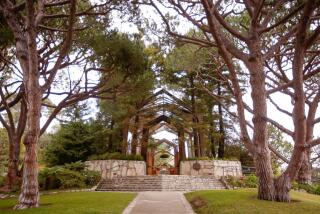Ancient undersea volcanoes off Antarctica hold climate secret
Ancient volcanoes discovered deep in the ocean off Antarctica may explain a climate mystery critical to predicting Earth’s fate as humans pump more carbon dioxide into the atmosphere.
University of Texas geologists dredging thousands of feet below the surface of the central Scotia Sea off the southeastern tip of South America hauled up volcanic rock after their sonar mapping showed formations that looked uncannily like a sunken island chain.
“It just didn’t look like real ocean floor,” said geologist Ian W. Dalziel, of the University of Texas, Austin, lead author of the paper published Thursday in the journal Geology. “We were seeing features that looked like they were sunken volcanoes, sitting on top of the old ocean floor.”
Their analysis of the rock and sonar data suggests that volcanoes erupting from the ancient sea floor formed an island arc that blocked the formation of the Antarctic circumpolar current, a critical mixer of ocean waters that created a thermal barrier locking Antarctica, and a good deal of Earth’s water, in its current deep freeze.
When the clockwise current formed and how it behaves are crucial to models that attempt to predict how Earth’s climate may shift as carbon dioxide levels approach those that occurred during a warm period about 15 million to 17 million years ago, during the Miocene epoch.
Climate, however, was not foremost on the minds of the geology team when it entered the Scotia Sea southeast of Argentina’s Tierra del Fuego.
“We started this from the point of view that we were interested in the nature of the seafloor in the central Scotia Sea to the east of Drake Passage because it was very enigmatic and nobody really understood it -- part of the world’s ocean basin about the size of France that we just didn’t understand at all,” Dalziel said.
The Drake Passage, between Antarctica and South America, opened up around the beginning of the Oligocene epoch about 34 million years ago, after a supercontinent that also included Australia and Tasmania began breaking up.
Paleoclimatologists have suggested that this opening completed the circumpolar current and created conditions for glaciers to begin forming on Antarctica. Dalziel’s work suggests the current was not the prime force behind glacial formation, but that it later thermally isolated the continent in its current deep freeze.
“Our suggestion is that the Antarctic circumpolar current might have been related to that descent into a deeper ice house, rather than the initiation of glaciation,” Dalziel said.
If the results hold true, they may help climate researchers resolve anomalies between carbon dioxide levels and global temperatures inferred from the microfossil record from the late Miocene epoch.
“The arc that we found looks like it was active until just the time when the global ocean temperatures dropped very precipitously in the late Miocene, so that we entered a much colder glaciation,” Dalziel said.
Based on the chemistry and physical characteristics of the rock samples, the undersea volcanoes probably were once visible islands, which sunk as the ocean’s crust cooled and became more dense, he said.
Rock samples matched the age of some of the oldest samples in the South Sandwich Islands, an arc of 11 active volcanoes in the east Scotia Sea. Dalziel said the original arc probably split, and part of it drifted to the location of the current island chain. Volcanic activity began there about 10 million years ago, as the South American plate slid under the Scotia plate.
Although the work involved careful examination of elemental isotopes and sophisticated imaging with multi-beam sonar, in the end the equivalent of extreme long-line trawling unraveled the mystery.
“We’re using high-tech sonar to detect where we’re going to dredge, but then you drop the equivalent of a geological hammer out there and you drag it up the slope and hope it catches onto something,” Dalziel siad.







